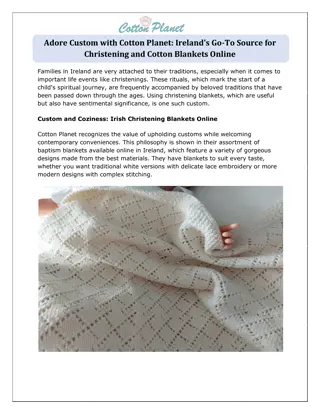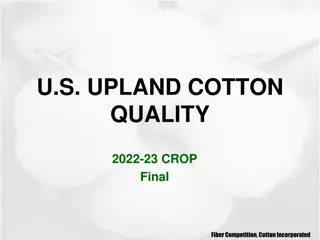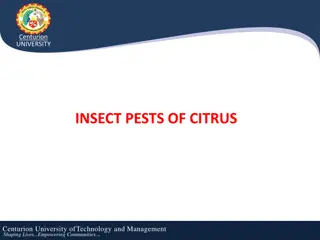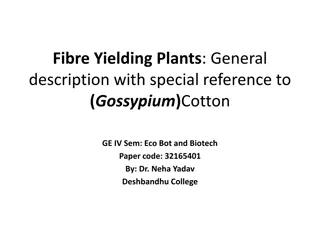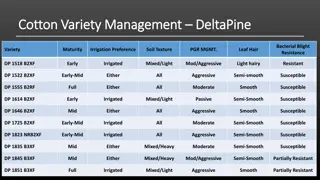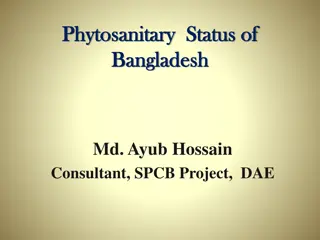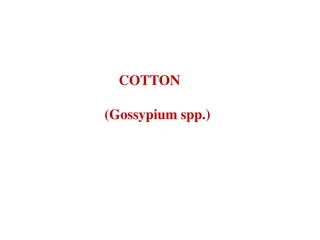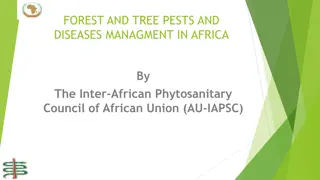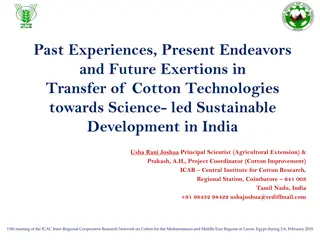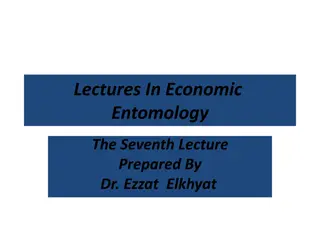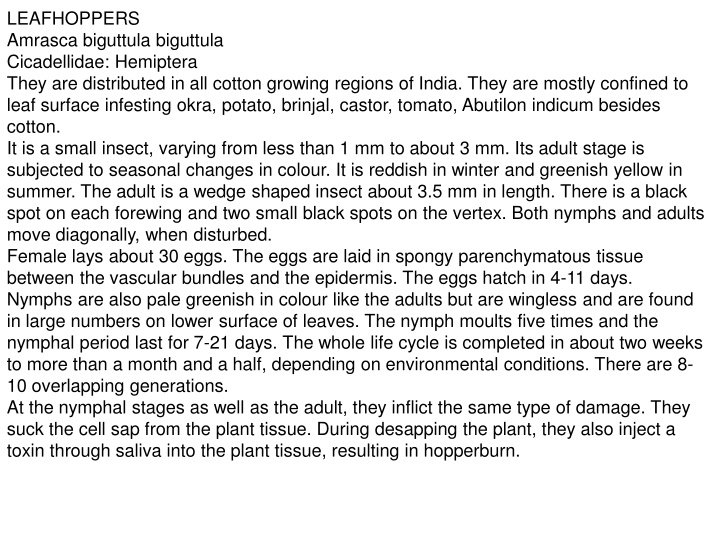
Cotton Pests in India
Learn about the leafhopper Amrasca biguttula biguttula and the whitefly Bemisia tabaci, common pests affecting cotton plants in India. Discover their characteristics, lifecycle, damage, and effective management techniques.
Download Presentation

Please find below an Image/Link to download the presentation.
The content on the website is provided AS IS for your information and personal use only. It may not be sold, licensed, or shared on other websites without obtaining consent from the author. If you encounter any issues during the download, it is possible that the publisher has removed the file from their server.
You are allowed to download the files provided on this website for personal or commercial use, subject to the condition that they are used lawfully. All files are the property of their respective owners.
The content on the website is provided AS IS for your information and personal use only. It may not be sold, licensed, or shared on other websites without obtaining consent from the author.
E N D
Presentation Transcript
LEAFHOPPERS Amrasca biguttula biguttula Cicadellidae: Hemiptera They are distributed in all cotton growing regions of India. They are mostly confined to leaf surface infesting okra, potato, brinjal, castor, tomato, Abutilon indicum besides cotton. It is a small insect, varying from less than 1 mm to about 3 mm. Its adult stage is subjected to seasonal changes in colour. It is reddish in winter and greenish yellow in summer. The adult is a wedge shaped insect about 3.5 mm in length. There is a black spot on each forewing and two small black spots on the vertex. Both nymphs and adults move diagonally, when disturbed. Female lays about 30 eggs. The eggs are laid in spongy parenchymatous tissue between the vascular bundles and the epidermis. The eggs hatch in 4-11 days. Nymphs are also pale greenish in colour like the adults but are wingless and are found in large numbers on lower surface of leaves. The nymph moults five times and the nymphal period last for 7-21 days. The whole life cycle is completed in about two weeks to more than a month and a half, depending on environmental conditions. There are 8- 10 overlapping generations. At the nymphal stages as well as the adult, they inflict the same type of damage. They suck the cell sap from the plant tissue. During desapping the plant, they also inject a toxin through saliva into the plant tissue, resulting in hopperburn.
In susceptible varieties, the attack results in mottling accompanied by the curling of the entire lamina with brown necrotic patches. Thus, the entire photosynthetic activity of the plant is very seriously interfered with. v Hopper burn i.e., the leaf margins turning yellowish initially and subsequently turning reddish and curling up. v Stunted growth of the plant. v Brown necrotic patches on the leaves. Irrigated conditions in the north and humid conditions in the south; high humidity and high temperature are favourable. ETL: 2-3 nymphs/leaf MANAGEMENT Growing resistant / tolerant varieties against leafhoppers. o L603,L 604,LRA 5166, NHH390, Lam hybrid 4,Saitha,Narasimha (NA 1325) ,NHH 44,H8 For sap feeders in general Seed treatment (after acid delinting) with Carbosulfan - 40 g/kg, Imidacloprid 70 WS - 5 g/kg, Thiamethoxam 70 WS - 4 g/kg gives protection for 30 days against sap feeders
Soil application carbofuran 3G 33 kg/ha (1 kg a.i./ha) at sowing Stem application (if seed is not treated) with insecticides using brush o Monocrotophos or methyl demeton 1:4 with water o Imidacloprid 200 SL 1: 20 with water Three times at 20 25, 30 35, 40 45 Days after sowing. ETL: 2 3 nymphs / leaf. o Foliar sprays with monocrotophos 1.5 ml/l or imidacloprid 0.4 ml/l or methyldemeton 2 ml/l or acetamiprid 0.2 g/l or acephate 1.5 g/l or phosalone 2 ml/l or phosphamidon 0.5 ml/l at 15 & 30 DAS WHITEFLY Bemisia tabaci Aleyrodidae: Hemiptera It is known to infest about 50 different species of plants but it becomes quite a serious pest of cotton in certain regions of the country. The infestation by this pest adversely affects the physiology of the cotton plant at all its stages of growth. It is distributed in all cotton growing regions of the world. It also infests radish, water melon, cucumber, chillies, brinjal, tomato, potato, tobacco etc Adult is minute insect measuring about 0.5 mm in length having white or greyish wings, a yellowish body and red medially constricted eyes.
A single female of this species lays about 70 stalked eggs singly on the undersurface of leaves, mostly on the top and middle leaves of plant. The insect can often breed parthenogenetically. The eggs are light yellow in the beginning but turn brown later on. Egg period ranges from 3-33 days. Nymphs are oval shaped, scale like, greenish yellow with marginal bristle like fringes. The nymphs remain stationary once they settle down. Nymphs moult thrice. Nymphal period lasts for 9-18 days. There are about a dozen overlapping generations in a year. Both nymphs and adults suck sap from lower side of leaves resulting in v Chlorotic spots which later coalesce forming irregular yellowing of leaves which extends from veins to outer edges. v The vegetative growth retarded and boll formation seriously hampered. v Shedding of the bolls accentuated and proper opening of the bolls interfered with Low quality lint and low oil content. v Sooty mould development due to honey dew excretion on infested parts. It is vector of leaf curl virus. The maximum infestation on cotton occurs during July. High temperature and low humidity are reported to be conducive to the multiplication of this pest.
MANAGEMENT A chalcid parasite attacks the older nymphs and the parasitisation is at times more than 30 per cent. Also, there are a few predators like some species of Chrysopa and coccinellids, which feed on the whitefly stages. Growing of tolerant varieties such as Kanchana (LPS 141); LK 861; NA 1280. ETL 5-10 nymphs/leaf Chemical control same as under cotton leaf hopper. COTTON APHID Aphis gossypii ,Aphididae: Hemiptera It is of worldwide distribution. It is a polyphagous species. However on cotton, often it causes appreciable damage during severe drought conditions. It also infests brinjal, chilies, amaranthus etc. Adult is small, soft, yellowish, green or greenish brown in colour. It is found in colonies of hundreds on tender shoot and undersurface of tender leaves. They are characterized by the presence of two tubes like structures called cornicles, on the abdomen. They are wingless normally but winged forms are often found mostly in the beginning and towards the end of season. Wings are thin, transparent and are held like a roof over the body.
They reproduce both sexually and parthenogenetically. Parthenogenetic females give rise to females ovo - viviparously. Nymphs are light yellowish green or brownish or greenish black in colour. They colonise growing points, lower surface of leaves and tender shoots. There are four instars. Nymphal period is about 7-9 days Both nymphs and adults suck the sap by remaining on the lower surface of the leaves. v Curled, faded and dried leaves. Development of black sooty mould due to honeydew excretion on infested parts. MANAGEMNT: Same as in cotton leafhopper. COTTON THRIPS Thrips tabaci, Scirtothrips dorsalis ,Thripidae: Thysanoptera Cotton thrips is a highly cosmopolitan form and is found on all kinds of vegetation. Onion and garlic, amaranthus, guava, solanaceous and cucurbitaceous plants, groundnut, chilies, mango, cabbage, bhendi etc. Nymphs and adults suck sap from leaves and flower buds. Margins of affected leaves get slightly curled up and the leaf blades show uneven surface, when attack occurs in flowering stage, the affected flowers may wither away. It is a vector of yellow spot virus and spotted wilt virus
IPM FOR SUCKING PESTS Growing toterant / resistant varieties or hybrids against leafhoppers and white flies. o Leafhoppers: Many varieties like MCU 5, LRA 5166, L 604, L 603, Narasimha (NA1325) & hybrids like NHH 44, Saritha, H8, jk Hy 1, LAHH Whiteflies: glabrous varieties like Kanchana (LPS 141), LK 861, L615, NA 1280, Supriya Soak the seed in concentrated sulphuric acid (100 ml/kg seed) for 2 3 minutes, wash with water 2 3 times followed by washing with lime supernatant, shade dry and treat with carbosulfan 40 g or imidacloprid 5 g along with little gum to protect against early season sucking pests. If untreated seed is sown, apply carbofuran 3G 12 14 kg/ac or phorate 10G 4 5 kg/ac nearer to the base of seedlings when the soil is moist. If the seed treatment is not done or granules are not applied, stem application using small brush with Monocrotophos or methyl demeton in 1:4 dilution Imidacloprid in 1:20 dilution at 20, 40, 60 DAS against sucking pests up to 75 days without harming natural enemies and environment and minimizing insecticide quantity.
Growing intercrops like blackgram, greengram, soybean, clusterbeans, cowpea,groundnut, Setaria contribute to build up of natural enemies and give extra income. High yielding varieties in two rows with 90 cm spacing, hybrids in three rows with 120 cm spacing. In whitefly endemic areas, keeping yellow empty tins smeared with greese as trap. Wipe out trapped whiteflies every day and apply greese again. In non IPM plots, spray monocrotophos 1.6 ml/l or dimethoate 2.0 ml/l or triazophos 2.5 ml/l or methyl demeton 2 ml/l or imidacloprid 0.4 ml/l o When there are 5 10 whiteflies / leaf o 1 2 leafhoppers / leaf 15 20 % aphid infested plants For mealy bug, dichlorvos 1 ml/l or methyl parathion 1 ml/l. For mites, sulphure 3 g/l or dicofol 5 ml/l
IPM FOR BOLLWORMS Deep ploughing exposes and eliminates hibernating insects and expose pupae to sun and predating birds. Balanced organic fertilization keeps crop healthy and tolerant to pest attack. Border crop with jowar, maize in 2 or 3 rows not only serves as a barrier for migration of insect pests but also pollen of maize helps in attraction of beneficial Chrysoperla to the field. Growing trap crops @ 100 plants/ acre. Castor as an ovipositional trap crop against S. litura: egg masses, gregarious larvae of S. litura on castor should be removed once in a week and destroyed. o Marigold as ovipositional trap crop against Helicoverpa o Okra (b hendi) against spotted bollworm moths. Spray marigold / okra plants with endosulfan or phosalone to minimize larval population Keep 10 15 pheromone traps / ha to attract male moths. Egg scouting from square initiation stage is desirable. o ETLS PBW: 8 moths, ABW: 10 moths, S. litura: 20 moths, SBW: 15 moths per trap per night.
Topping (removal of leaf terminals) for 80 100 days old crop during October November since tender leaves and tips are preferred for egg laying. Spray 5% neem seed kernel extract (NSKE) (soak 10 kg neem seed powder in 200 litres of water for 24 h and filter through muslin cloth) to repel moths from egg laying and to kill eggs and early instar larvae. Install T shaped or long dried twigs as bird perches to attract predatory birds @ 20 / ac. Spray NPV @ 200 LE / ac in combination with jaggery 1 kg, sandovit 100 ml or Robin Blue 50 g thrice at 10-15 days interval on observing the eggs or first instar larvae in the evening hours. The diseased larvae die after 4 5 days showing tree top symptoms. Spray commercially available B. t formulations (DIPEL, DELFIN, BIOBIT, HALT) @ 400 g or 400 ml/ac against Helicoverpa On the basis of ETLs spray the following insecticides, endosulfan 2 ml/l or chlorpyriphos 2 ml/l or quinalphos 2 ml/l or methylparathion 1 ml/l or carbaryl 3 g/l or triazophos 2 ml/l or thiodicarb 1.5 g/l or profenophos 2 ml/l Mixing mustard oil with endosulfan 1:2 or chlorpyriphos 1:4 improves toxicity In the entire schedule of spray, do not spray synthetic pyrethroids for more than two rounds.



